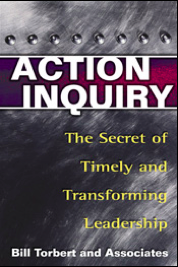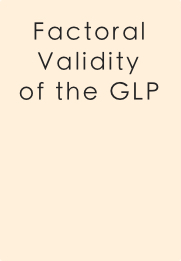Torbert has been involved in testing the validity of several developmental leadership measures that are close equivalents, and the GLP is the latest version, building on the validity of the others, while improving upon them in various ways. For example, we now offer each person who takes the GLP a Self-Estimate document that supports making your own subjective estimate of your centre-of-gravity action-logic before receiving our relatively objective estimate. This process generates better conversation afterwards both within yourself and with a coach.
Also, we no longer depend merely on occasional testing of reliability between scorers. Instead, each set of sentence completions submitted is tested for reliability between two of the half dozen most senior scorers of such developmental instruments.
Finally, even more important than the already-established validity of the objective GLP instrument is the catalytic validity that engaging the action inquiry process at a workshop or with an executive coach achieves on behalf of your ongoing transformation to later leadership action-logics.
Collaborative Developmental Action Inquiry
Read more about the research behind Collaborative Developmental Action Inquiry (CDAI)
All of Torbert’s research interweaves quantitative, qualitative, and action methodologies, and is written up in first-, second-, and third-person voices. In particular, the third-person psychometric measure of persons’ developmental action-logics – the Global Leadership Profile (the GLP, progressively evolved from Loevinger’s Washington University Sentence Completion Test [WUSCT] since 1980) has undergone the widest range of validity and reliability testing of any measure we know. The tests of the GLP run the gamut from conventional reliability tests and internal validity tests, to use of the measure in laboratory and field experiments, and in predicting the outcomes of studies using non-obtrusive measures, interview analyses, behaviour-scoring schemes, and analyses of organizational case studies. In many cases, the variance in the GLP accounted for more than half of the variance in the dependent variables beyond the .01 level of significance – very unusual for social science studies.
The best and most recent methodological reviews of CDAI and the GLP are found in the ‘Concluding Scientific Postscript’ of Torbert, 2004, in the 2013 Integral Review refereed article “Listening into the Dark” and in the 2016 paper “Brief Comparison of Five Developmental Measures”. In 1972, when Torbert’s first book in this area was published, there was no field of adult development. Since then, Ken Wilber’s The Atman Project, 1980, and later books; Bob Kegan’s The Evolving Self, 1982, and later books; and Susanne Cook-Greuter’s Postautonomous Ego Development, 1999, among many others, have helped to define the field.
What remains distinctive about the contribution of CDAI is that its methods are applied to the researchers themselves as well as other participants, that its methods are applied in action settings, and that its methods generate not only single-loop feedback, but also double- and triple-loop feedback. Put differently, CDAI offers dynamic, transformational action research methods that theorize, document, and catalyze not only individual, adult development, but also organizational development, and scientific paradigm change.
In the past twenty years, PhD dissertations by Hilary Bradbury, Aftab Erfan, Erica Foldy, Ed Kelly, Valerie Livesay, David McCallum SJ, Cara Miller, Aliki Nicolaides, Robin Postel, Shakiyla Smith, and Karen Yeyinman have all used elements of CDAI theory, practice, and method. (Several of these dissertations can be found listed in Research) Also, these authors and others are responsible for some 15 chapters in 2015 Handbook of Action Research..(Several also listed in Research)

Action Inquiry
Bill Torbert and associates illustrate how individuals and organizations can progress through more and more sophisticated “action-logics” — strategies for analyzing the world and reacting to it — until they will eventually be able to practice action inquiry continually. Offering action inquiry exercises at the end of the chapters, the book moves from junior managers beginning to practice action inquiry through CEO’s transforming whole companies, to world leaders transforming whole countries, as exemplified by Czech president Vaclav Havel.
Through short stories of leadership and organizational transformations, this groundbreaking book illustrates how action inquiry increases personal integrity, relational mutuality, company profitability, and long-term organizational and environmental sustainability.
– Offers a powerful method that leaders in organizations of all types can use to increase the timeliness and effectiveness of their actions
– Provides numerous real-world examples of action inquiry in action
– Includes exercises individuals and organizations can use to begin practicing action inquiry

HARVARD BUSINESS REVIEW ARTICLE
Seven Transformations of Leadership
Most developmental psychologists agree that what differentiates one leader from another is not so much philosophy of leadership, personality, or style of management. Rather, it’s internal “action logic”–how a leader interprets the surroundings and reacts when his or her power or safety is challenged.
Relatively few leaders, however, try to understand their action logic, and fewer still have explored the possibility of changing it. They should, because leaders who undertake this voyage of personal understanding and development can transform not only their own capabilities but also those of their companies.
In 2012, HBR chose this article as one of its 10 best leadership articles ever for its new book on the Top Ten Leadership MUST READS.

Validity and Reliability of AI Scoring of GLA’s Developmental Psychometrics
In this paper we describe the way in which we developed an AI model to score the GLP, a leadership-focused psychometric. The accuracy of such a model is important since it forms feedback to an individual about their work, giving them clues as to how they can reach out and transform themselves and their situation rather than withdrawing from complexity in the world.
Since this AI scoring model was originally deployed in 2021, GLA has launched a derivative of the GLP, called MyWorldView (MWV). The scoring mechanisms for the two are identical, save for the granularity at which the scores are fed back to the user. As such, this paper should be taken to cover the automated scoring of both the original GLP psychometric and the newer MWV assessment.

Reut Livne-Tarandach and Bill Torbert
Boston College
